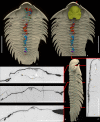Uniquely preserved gut contents illuminate trilobite palaeophysiology
- PMID: 37758946
- PMCID: PMC10584673
- DOI: 10.1038/s41586-023-06567-7
Uniquely preserved gut contents illuminate trilobite palaeophysiology
Abstract
Trilobites are among the most iconic of fossils and formed a prominent component of marine ecosystems during most of their 270-million-year-long history from the early Cambrian period to the end Permian period1. More than 20,000 species have been described to date, with presumed lifestyles ranging from infaunal burrowing to a planktonic life in the water column2. Inferred trophic roles range from detritivores to predators, but all are based on indirect evidence such as body and gut morphology, modes of preservation and attributed feeding traces; no trilobite specimen with internal gut contents has been described3,4. Here we present the complete and fully itemized gut contents of an Ordovician trilobite, Bohemolichas incola, preserved three-dimensionally in a siliceous nodule and visualized by synchrotron microtomography. The tightly packed, almost continuous gut fill comprises partly fragmented calcareous shells indicating high feeding intensity. The lack of dissolution of the shells implies a neutral or alkaline environment along the entire length of the intestine supporting digestive enzymes comparable to those in modern crustaceans or chelicerates. Scavengers burrowing into the trilobite carcase targeted soft tissues below the glabella but avoided the gut, suggesting noxious conditions and possibly ongoing enzymatic activity.
© 2023. The Author(s).
Conflict of interest statement
The authors declare no competing interests.
Figures














Similar articles
-
The oldest known digestive system consisting of both paired digestive glands and a crop from exceptionally preserved trilobites of the Guanshan Biota (Early Cambrian, China).PLoS One. 2017 Sep 21;12(9):e0184982. doi: 10.1371/journal.pone.0184982. eCollection 2017. PLoS One. 2017. PMID: 28934290 Free PMC article.
-
Direct evidence for predation on trilobites in the Cambrian.Proc Biol Sci. 2004 Aug 7;271 Suppl 5(Suppl 5):S277-80. doi: 10.1098/rsbl.2004.0194. Proc Biol Sci. 2004. PMID: 15503993 Free PMC article.
-
Controls on gut phosphatisation: the trilobites from the Weeks Formation Lagerstätte (Cambrian; Utah).PLoS One. 2012;7(3):e32934. doi: 10.1371/journal.pone.0032934. Epub 2012 Mar 14. PLoS One. 2012. PMID: 22431989 Free PMC article.
-
Reappraising the early evidence of durophagy and drilling predation in the fossil record: implications for escalation and the Cambrian Explosion.Biol Rev Camb Philos Soc. 2018 May;93(2):754-784. doi: 10.1111/brv.12365. Epub 2017 Oct 2. Biol Rev Camb Philos Soc. 2018. PMID: 28967704 Review.
-
Trilobite body patterning and the evolution of arthropod tagmosis.Bioessays. 2003 Apr;25(4):386-95. doi: 10.1002/bies.10270. Bioessays. 2003. PMID: 12655645 Review.
Cited by
-
The SmARTR pipeline: A modular workflow for the cinematic rendering of 3D scientific imaging data.iScience. 2024 Nov 23;27(12):111475. doi: 10.1016/j.isci.2024.111475. eCollection 2024 Dec 20. iScience. 2024. PMID: 39720527 Free PMC article.
References
-
- Fortey, R. A. & Owens, R. M. in Treatise on Invertebrate Paleontology, Part O, Arthropoda 1, Trilobita, revised. Volume 1: Introduction, Order Agnostida, Order Redlichiida (ed. Kaesler, R. L.) 249–287 (Geological Society of America & Univ. of Kansas, 1997).
-
- Fortey, R. A. The palaeoecology of trilobites. J. Zool.292, 250–259 (2014).10.1111/jzo.12108 - DOI
-
- Fatka, O., Budil, P. & David, M. Digestive structures in Ordovician trilobites Colpocoryphe and Flexicalymene from the Barrandian area of Czech Republic. Est. J. Earth Sci.64, 255–266 (2015).10.3176/earth.2015.32 - DOI
-
- Havlíček, V. Development of a linear sedimentary depression exemplified by the Prague basin (Ordovician–Middle Devonian; Barrandian area – central Bohemia). Sbor. Geol. Věd, Geol.35, 7–48 (1981).
MeSH terms
LinkOut - more resources
Full Text Sources

